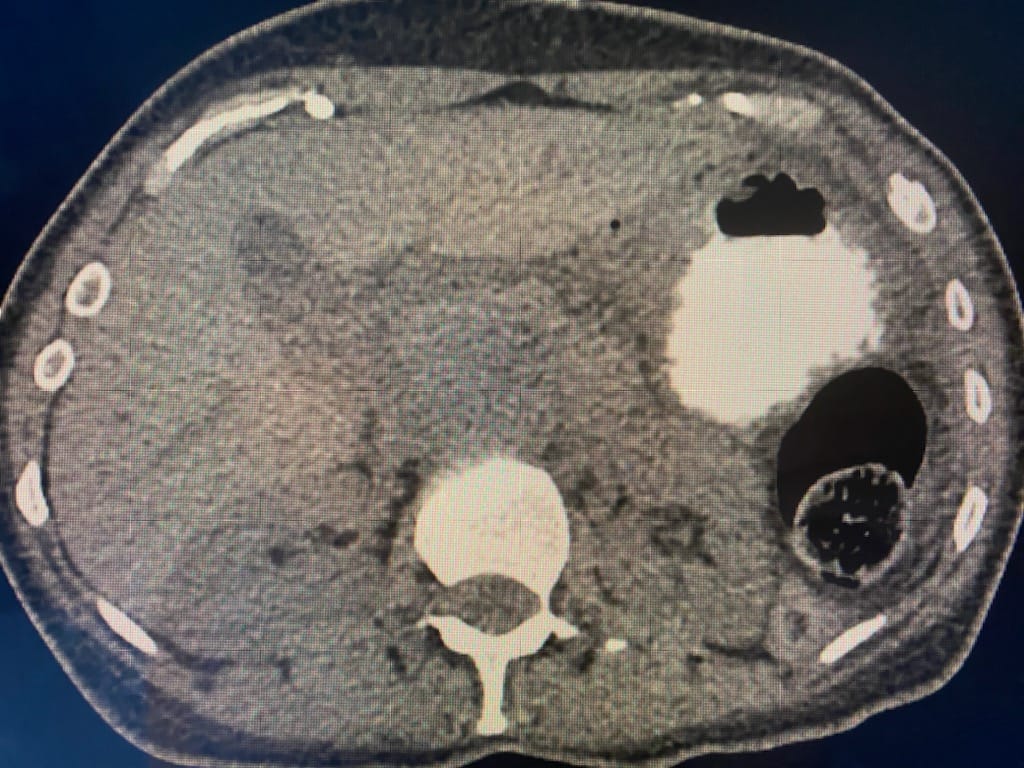Monday Poster Session
Category: Stomach
P3398 - The Quiet Menace: Unmasking Signet Ring Cell Carcinoma Through Gastric Perforation
Monday, October 28, 2024
10:30 AM - 4:00 PM ET
Location: Exhibit Hall E

Has Audio

Kanza Shamim, MD
Nassau University Medical Center
Merrick, NY
Presenting Author(s)
Kanza Shamim, MD1, Thanh P D Vu, 2, Rucha Jiyani, MD3, Khawaja Ahmed Salman Zaki, MD3, Shadab Ahmed, MD3
1Nassau University Medical Center, Merrick, NY; 2American University of the Caribbean School of Medicine, East Meadow, NY; 3Nassau University Medical Center, East Meadow, NY
Introduction: Gastric cancer (GC)is the third leading cause of cancer death and the fifth most common malignancy worldwide. 90% of GC are adenocarcinoma1, of which Signet ring cell carcinoma (SRCC) is a subtype, and accounting at approximately 15.1-28% of all GC.2 It has a mean age of diagnosis at 52.6 years, with female predominance.3SRCC is characterized by the presence of malignant cells with prominent intracytoplasmic mucin, displacing the nucleus to one side, giving a characteristic "signet ring" appearance.4These gastric SRCC likely to invade the peritoneum (peritoneal carcinomatosis) and develops seedings to the lungs or, and to the ovaries, forming Krukenberg tumors ⁵. Gastric perforation as the initial presentation of SRCC is exceedingly rare, at only 0.56-3.9% of all cases of GC.⁶ However, it carries a high mortality (8-82%) and thus should be considered as a possible initial presentation. ⁷
Case Description/Methods: 51-year-old female with complaint of sudden onset acute abdominal pain associated with nausea. As per patient had new onset acid reflux for the past 3-4 months and weight loss of > 20 pounds. Abdominal X-ray showed free air under diaphragm, indicating a perforated viscus. CT of the abdomen confirmed perforation with irregular thickening of the distal stomach with ulceration and shouldered margins suspicious for malignancy. Patient underwent emergent exploratory laparotomy. During surgery, intraoperative EGD was done that showed necrotic perforated ulcer and gastric perforation along anterior wall. Biopsies were obtained and histology revealed poorly differentiated invasive adenocarcinoma with mucin and signet ring cells infiltrating the gastric wall.
Discussion: SRCC of stomach is known for its aggressive behavior and poor prognosis. Its presentation as gastric perforation is rare and poses significant diagnostic and therapeutic challenges. In this case, the perforation led to an urgent diagnosis, but unfortunately, the disease was already at an advanced stage with krukenburg tumors. Gastric perforation typically presents with acute abdomen and requires immediate surgical intervention. Histopathological examination remains crucial in diagnosing SRCC and determining the extent of disease. Early diagnosis and treatment are essential in improving outcomes in SRCC. However, the insidious nature of the disease often leads to delayed diagnosis. Gastric perforation, though rare, should be considered a possible initial presentation of SRCC in patients presenting with acute abdomen pain.

Disclosures:
Kanza Shamim, MD1, Thanh P D Vu, 2, Rucha Jiyani, MD3, Khawaja Ahmed Salman Zaki, MD3, Shadab Ahmed, MD3. P3398 - The Quiet Menace: Unmasking Signet Ring Cell Carcinoma Through Gastric Perforation, ACG 2024 Annual Scientific Meeting Abstracts. Philadelphia, PA: American College of Gastroenterology.
1Nassau University Medical Center, Merrick, NY; 2American University of the Caribbean School of Medicine, East Meadow, NY; 3Nassau University Medical Center, East Meadow, NY
Introduction: Gastric cancer (GC)is the third leading cause of cancer death and the fifth most common malignancy worldwide. 90% of GC are adenocarcinoma1, of which Signet ring cell carcinoma (SRCC) is a subtype, and accounting at approximately 15.1-28% of all GC.2 It has a mean age of diagnosis at 52.6 years, with female predominance.3SRCC is characterized by the presence of malignant cells with prominent intracytoplasmic mucin, displacing the nucleus to one side, giving a characteristic "signet ring" appearance.4These gastric SRCC likely to invade the peritoneum (peritoneal carcinomatosis) and develops seedings to the lungs or, and to the ovaries, forming Krukenberg tumors ⁵. Gastric perforation as the initial presentation of SRCC is exceedingly rare, at only 0.56-3.9% of all cases of GC.⁶ However, it carries a high mortality (8-82%) and thus should be considered as a possible initial presentation. ⁷
Case Description/Methods: 51-year-old female with complaint of sudden onset acute abdominal pain associated with nausea. As per patient had new onset acid reflux for the past 3-4 months and weight loss of > 20 pounds. Abdominal X-ray showed free air under diaphragm, indicating a perforated viscus. CT of the abdomen confirmed perforation with irregular thickening of the distal stomach with ulceration and shouldered margins suspicious for malignancy. Patient underwent emergent exploratory laparotomy. During surgery, intraoperative EGD was done that showed necrotic perforated ulcer and gastric perforation along anterior wall. Biopsies were obtained and histology revealed poorly differentiated invasive adenocarcinoma with mucin and signet ring cells infiltrating the gastric wall.
Discussion: SRCC of stomach is known for its aggressive behavior and poor prognosis. Its presentation as gastric perforation is rare and poses significant diagnostic and therapeutic challenges. In this case, the perforation led to an urgent diagnosis, but unfortunately, the disease was already at an advanced stage with krukenburg tumors. Gastric perforation typically presents with acute abdomen and requires immediate surgical intervention. Histopathological examination remains crucial in diagnosing SRCC and determining the extent of disease. Early diagnosis and treatment are essential in improving outcomes in SRCC. However, the insidious nature of the disease often leads to delayed diagnosis. Gastric perforation, though rare, should be considered a possible initial presentation of SRCC in patients presenting with acute abdomen pain.

Figure: CT shows Irregular thickening of the distal stomach with ulceration and shouldered margins suspicious of malignancy
Disclosures:
Kanza Shamim indicated no relevant financial relationships.
Thanh P D Vu indicated no relevant financial relationships.
Rucha Jiyani indicated no relevant financial relationships.
Khawaja Ahmed Salman Zaki indicated no relevant financial relationships.
Shadab Ahmed indicated no relevant financial relationships.
Kanza Shamim, MD1, Thanh P D Vu, 2, Rucha Jiyani, MD3, Khawaja Ahmed Salman Zaki, MD3, Shadab Ahmed, MD3. P3398 - The Quiet Menace: Unmasking Signet Ring Cell Carcinoma Through Gastric Perforation, ACG 2024 Annual Scientific Meeting Abstracts. Philadelphia, PA: American College of Gastroenterology.
